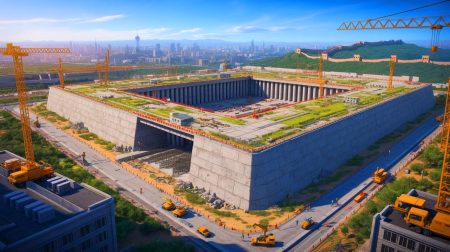| IN A NUTSHELL |
|
In a groundbreaking development, Chinese rocket startup Landspace has successfully conducted a static fire test for its Zhuque-3 rocket, marking a significant milestone in China’s ambitious space endeavors. This test is a crucial step toward the eventual orbital launch of the Zhuque-3, a reusable rocket designed to propel China into the forefront of space technology alongside giants like SpaceX. The static fire took place at the Dongfeng Commercial Space Innovation Test Zone, showcasing China’s commitment to advancing its reusable launch vehicle capabilities. As the global space race intensifies, Landspace’s successful test underscores its potential to emerge as a major player in the industry.
Zhuque-3 Rocket Orbital Launch Preparations
Landspace’s Zhuque-3 rocket is poised to revolutionize China’s approach to space exploration. At the heart of this vehicle is the Tianque-12A engine, a proprietary technology utilizing methane and liquid oxygen as propellants. This innovative engine design promises increased efficiency and reduced environmental impact, a nod to the future of sustainable space travel. During the static fire test, the rocket’s nine engines ignited sequentially, generating an impressive 7,542 kilonewtons of thrust for 45 continuous seconds. This successful test is a testament to Landspace’s engineering prowess and a precursor to the rocket’s upcoming first flight.
Landspace’s achievements are part of a broader movement within Chinese aerospace to emulate the success of SpaceX’s reusable rocket technology. With Space Pioneer already making headlines by reaching orbit on its first attempt, the race is on for Chinese companies to establish themselves as leaders in the space industry. The Zhuque-3’s successful static fire test is a significant step in this direction, laying the groundwork for future advancements in China’s space capabilities.
Landspace’s Launch Plans
Looking ahead, Landspace has ambitious plans for the Zhuque-3 rocket. The first orbital launch is tentatively scheduled for the third quarter of the year, featuring the prototype of the reusable Haolong cargo spacecraft. Developed by the Chengdu Aircraft Design Institute, the Haolong spacecraft represents a new era in reusable space technology, aligning with global trends towards sustainability and cost-efficiency.
Landspace’s journey has not been without challenges. The company’s initial launch attempt in 2018 with the Zhuque-1 vehicle ended in failure. However, perseverance paid off in July 2023 when the Zhuque-2 became the first methane-liquid oxygen rocket to reach orbit. This resilience highlights Landspace’s commitment to innovation and its potential to make significant contributions to the global space industry. As Landspace prepares for the Zhuque-3’s inaugural flight, the successful static fire test serves as a crucial validation of its capabilities.
The Significance of Static Fire Tests
Static fire tests are a vital component of rocket development, serving as a dress rehearsal for the actual launch. During these tests, the rocket stage is anchored to the ground, and the engines are fired to assess their performance. This step is critical in ensuring that all systems function correctly before the full-scale launch. While these tests are essential, they are not without risk. SpaceX’s recent Starship test exemplifies the potential for dramatic outcomes, with a massive explosion following a static fire attempt.
Landspace’s recent successful static fire test demonstrates the company’s meticulous attention to detail and comprehensive testing procedures. By performing essential steps such as propellant loading, tank pressurization, and staged engine ignition, Landspace has ensured that the Zhuque-3 is well-prepared for its upcoming launch. This achievement is a testament to the company’s commitment to safety and precision in its pursuit of space exploration.
The Future of Reusable Rockets
The Zhuque-3 rocket represents the future of China’s space ambitions, with a focus on reusable technology that promises to reduce costs and increase efficiency. Weighing approximately 1,257,000 pounds (570 metric tons) at launch and standing at a height of 217 feet (66 meters), the Zhuque-3 is named after the Vermillion bird from Chinese mythology, symbolizing renewal and transformation. This naming is fitting, as the rocket embodies China’s aspirations for a leading role in the global space race.
As Landspace prepares for the Zhuque-3’s orbital launch, the world watches with anticipation. The successful static fire test marks a pivotal moment in the company’s journey towards becoming a major player in space exploration. With reusable technology at the forefront, the Zhuque-3 sets the stage for a new era in China’s space program, challenging established players and pushing the boundaries of what is possible.
With the Zhuque-3’s successful static fire test, Landspace is on the brink of a significant leap forward in space technology. This achievement reinforces China’s position as a formidable contender in the global space race, with ambitions to rival and perhaps surpass established aerospace giants. As the Zhuque-3 continues to progress towards its first orbital launch, we are left to wonder: How will the emergence of reusable rocket technology reshape the future of space exploration and international cooperation in the coming decades?
Did you like it? 4.6/5 (26)









Wow, nine engines? That’s some serious power! 🚀
Is it true that the Zhuque-3 can actually compete with SpaceX? 🤔
It’s amazing to see China making such strides in space technology! Keep it up, Landspace! 🌌
How does the Zhuque-3 compare to SpaceX’s Falcon 9 in terms of cost-efficiency?
A static fire is not a successful launch and re-use. Furthermore “shook spaceX dominance” NASA isn’t going to use a Chinese built rocket lol.
Is the methane-liquid oxygen combination better for the environment than traditional rocket fuels?
When’s the next launch? Can’t wait to see it in action! 🚀
Static fire tests are always nerve-wracking. Kudos to the team for pulling it off!
Why do they call it the “monster”? Nine engines seems a bit excessive, doesn’t it? 😅
How does the Zhuque-3’s thrust compare to other rockets currently in service?
Can this rocket really dethrone SpaceX or is it just media hype?
I hope this paves the way for more sustainable space travel. 🌍
Great to see competition in the space industry. Keeps everyone on their toes!
Do you think this could lead to cheaper space missions in the future? 💸
Are there any potential risks with using methane-liquid oxygen as propellants?
Another step forward for China! Looking forward to seeing where this goes. 🇨🇳
What are the chances of the first orbital launch being successful?
This is incredible news! Can’t wait for the Zhuque-3 to make its mark.
How does Landspace’s approach differ from SpaceX’s when it comes to reusable technology?
Such an impressive achievement! Hats off to the engineers and scientists involved. 🎩
What lessons did Landspace learn from its previous launch failure in 2018?
Does anyone know if the test was live-streamed? Would love to see it!
How long before we see reusable rockets as a standard in the industry?
Why isn’t this headline news everywhere? Seems like a big deal to me.
I’m a bit skeptical. Can Landspace really pull this off and compete globally?
Love the fact that the rocket is named after a mythological bird! 🐦
With so many engines, what happens if one fails during a launch?
Can’t wait to see how this affects the global space race. Exciting times ahead! 🚀
This is just the beginning. Looking forward to more innovations from Landspace.
How often do they plan to reuse the Zhuque-3? Any official word on that?
Hope this leads to more international cooperation in space exploration. 🌌
Is the static fire test similar to what SpaceX does, or is it a different process?